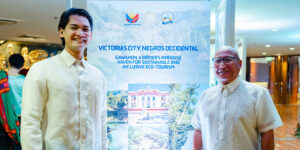The implementation of the barangay drug-clearing program highly depends on the barangay officials’ support and cooperation to curb the proliferation of illegal drugs in the communities.
This was cited by Provincial Anti-Drug Abuse Council action officer Fernando Martinez, in view of the status of Negros Oriental as the most drug-affected in Region 7.
Martinez said records on drug affectation in the province may not strictly reflect the situation on the ground as drug-related crimes logged are quite low compared to previous years.
“The problem on illegal drugs may not actually be prominent in all localities,” he added.
He said the drug-clearing program in the barangay is possible as long as there is cooperation among concerned agencies, particularly the barangays, to fast-track the required documentation.
Martinez urged the barangay officials, youth, and other concerned agencies to intensify their anti-illegal drug campaign.
Agent Elmer Ebona of the Philippine Drug Enforcement Agency said that currently, most of the local government units have improved their anti-illegal drug efforts, as nine barangays have submitted the required documents due for deliberations for drug-cleared declaration.
He said he hopes that the number of drug-affected barangays will be reduced in the remaining months for this year.
In a Provincial Peace and Order Council meeting, the PADAC reported that 3,469 “tokhang” drug surrenderers have completed their community-based rehabilitation and treatment program amid the Covid-19 pandemic in their barangays.
Under the community-based approach, the participants or persons who used drugs will undergo six to nine months of rehabilitation program, after which they will receive livelihood assistance from the different government agencies.
The community-based treatment and rehabilitation program is part of President Rodrigo Duterte’s response to the ongoing drug abuse prevention program in the country.
This is guided by the Comprehensive Dangerous Drugs Act of 2002 that mandates that “it is the State’s policy to provide effective mechanisms or measures to reintegrate into society individuals who have fallen victims to drug abuse or dependence through sustainable programs of treatment and rehabilitation.”
DRUG-AFFECTATION
The PDEA reported that 75.40 percent of the barangays in Negros Oriental were still affected by illegal drugs, as of last month.
Ebona said 91 barangays have been drug-cleared, two remain unaffected, 51 were certified unaffected, and 413 barangays were considered drug-affected.
Of the 22 barangays in Sta. Catalina town, 20 have been declared drug-cleared and the two barangays were already tagged drug-free.
Sta. Catalina would have been declared a “Drug-Cleared Municipality” but Ebona said it lacks a drug reformatory facility or Balay Silangan, which is a major requirement before it can be declared as such by the Regional Oversight Committee.
Balay Silangan, a community-based reformation program aimed at rehabilitating surrendered drug personalities, seeks to build temporary shelters for drug offenders with the aim of reforming them to become self-sufficient and law-abiding members of society.
Ebona said the drug reformists will undergo month-long general interventions, such as continuing education and health awareness and psychological/spiritual/physical activities, including counseling, moral recovery, values formation, personal and life skills, and livelihood and skills training programs to give reformers employment opportunities.
The five LGUs in the province that have started putting up Balay Silangan are Canlaon City, Ayungon, La Libertad, Basay, and Mabinay.
With Negros Oriental being the most affected province in Central Visayas, Ebona said there is a need to urther strengthen the tie-up between law enforcement units, the Department of Health, Department of Interior and Local Government, LGUs, non-government organizations, and other government agencies for a more concentrated effort in addressing the drug affectation in each locality.
Local Anti-Drug Abuse Councils in each locality must implement the Barangay Drug Clearing Program to address the drug affectation in their areas.
The parameters to declare a barangay as drug-cleared also include the active involvement of barangay officials in anti-drug activities, Sangguniang Kabataan’s active involvement in maintaining drug-free status, existence of drug awareness, preventive education and information, and putting up of drug treatment and rehabilitation processing help desks.
DRUG HAUL
The PDEA also reported the seizure of 1,162.676 grams of shabu, worth about P7,906,196, from January to July 2021.
Thirty-five cases for violation of Republic Act 9165, or the Comprehensive Dangerous Drugs Act of 2002, and other related charges were also filed in court that same period.
OVER 1K DRUG USERS
In Dumaguete, the PDEA said it logged 1,013 persons who use drugs in the City.
Ebona said majority of the drug users were identified from 2016 to 2018.
PDEA also reported that, of the 30 barangays of Dumaguete, only one was drug-cleared and three were drug-free.
In the second district of Negros Oriental, which includes Dumaguete, only 28 barangays were drug-cleared and 13 drug-free out of the total 174 barangays.
In the first district, four were drug-cleared and 31 drug-free of the 218 barangays, while in the third district, 51 were drug-cleared and seven drug-free, out of the total 155 barangays, the PDEA earlier reported.
Drug-cleared barangays are classified as areas that were previously drug-affected and have been subjected to drug clearing operations and declared “cleared” from any illegal drug activities, based on the parameters set by the Dangerous Drugs Board.
Drug-free barangays are unaffected by drugs and have no presence of drug personalities or illegal drug activities.
The Dumaguete City Social Welfare and Development Office has been tasked to undertake the aftercare of those who completed the 13-session Matrix Intensive Outpatient Treatment Program so they can avail of livelihood opportunities and be integrated to the mainstream society.
Liga ng mga Barangay president Dionie Amores and Sangguniang Kabataan president Renz Macion also pledged to continue the information drive against illegal drugs use in the barangays and among the youth.*PIA







